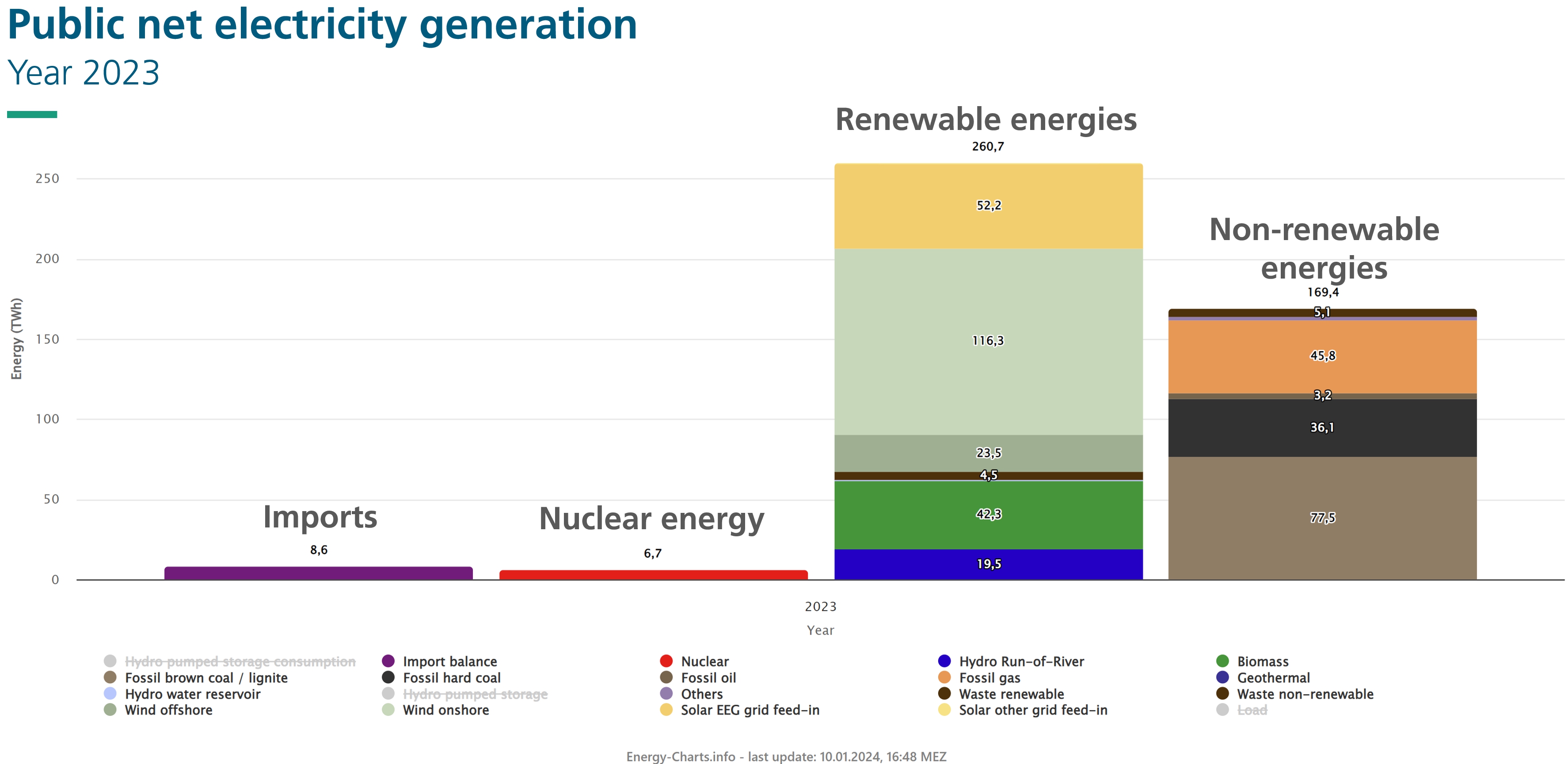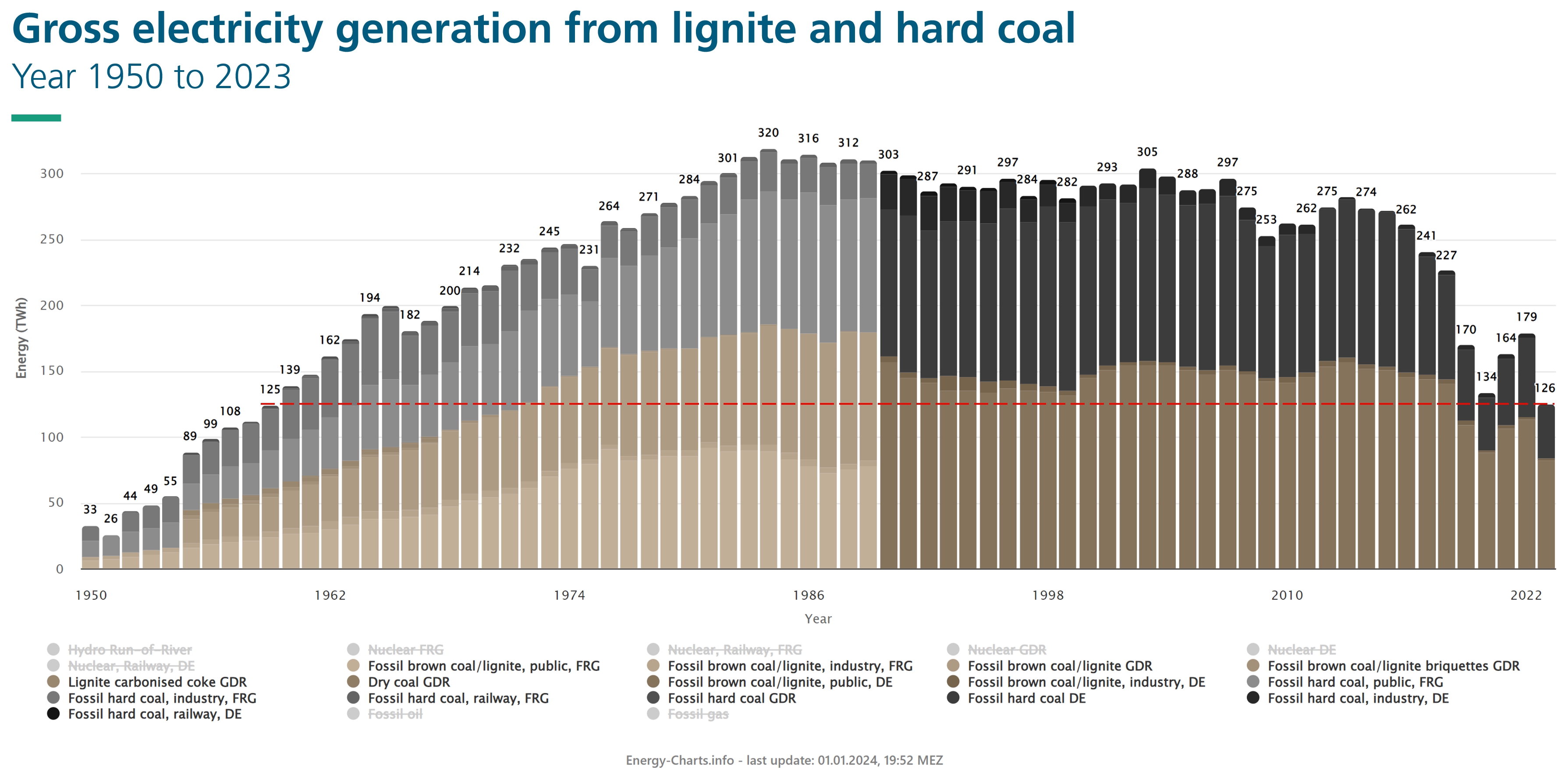Press Release #01
Public Net Electricity Generation 2023 in Germany: Renewables Cover the Majority of the Electricity Consumption for the First Time
In 2023, renewables accounted for a record share of 59.7 percent of the net public net electricity generation in Germany. The share of renewables in the load (the electricity mix coming from the socket) was 57.1 percent. This is the result of an analysis presented this week by the Fraunhofer Institute for Solar Energy Systems ISE. New records were also set for wind and solar power in 2023. In contrast, generation from lignite (minus 27 percent) and hard coal (minus 35 percent) fell sharply. Newly installed photovoltaic capacity was in the double digits for the first time, amounting to around 14 gigawatts for 2023. This significantly exceeded the German government's statutory climate protection target. All the data for these statistics can be found on the platform energy-charts.info.


Wind power was once again the most important source of electricity in 2023, contributing 139.8 terawatt hours (TWh) or 32% to public net electricity generation. This was 14.1% higher than the previous year's production. The share of onshore wind power rose to 115.3 TWh (2022: 99 TWh), while offshore production fell slightly to 23.5 TW (2022: 24.75 TWh). The expansion of wind energy continues to lag behind the government’s plan: By November 2023, only 2.7 gigawatts (GW) of onshore wind had been newly installed, compared to the planned 4 GW. The expansion of offshore wind farms is even slower: In 2023, only 0.23 GW offshore wind capacity was newly installed, compared to the planned amount of 0.7 GW, due to required tenders and long construction times.
Photovoltaic systems generated around 59.9 TWh electricity in 2023, of which 53.5 TWh was fed into the public grid and 6.4 TWh was used for self-consumption. Nine TWh, the highest monthly solar power generation ever achieved in Germany, was produced in June 2023. The maximum solar output of 40.1 GW was reached on July 7 at 13:15, which corresponded to 68% of electricity generation. In 2023, photovoltaic capacity expansion significantly exceeded the German government's targets: Instead of the planned 9 gigawatts, 13.2 gigawatts of PV were installed by November. When all installation data for 2023 become available, final figures for new PV installations in 2023 are expected to be above 14 gigawatts. This is a sharp increase compared to 2022 (7.44 GW) and is the first time that PV expansion in Germany has seen double-digit growth.
The contribution from hydropower increased compared to 2022, from 17.5 TWh to 20.5 TWh. The installed capacity of 4.94 GW, however, has hardly changed compared to previous years. At 42.3 TWh, biomass was at the same level as in 2022 (42.2 TWh). The installed capacity biomass is 9 GW.
In total, renewables produced around 260 TWh in 2023, around 7.2% more than in the previous year (242 TWh). The share of renewable energy generated in Germany in the load, i.e., the electricity mix that comes out of the socket, was 57.1%, compared to 50.2% in 2022. In addition to public net electricity generation, total net electricity generation also includes in-house generation by industry and commerce, which is mainly generated using gas. The share of renewable energy in total net electricity generation, including the power plants operated by “establishments in the manufacturing sector, mining and quarrying", is around 54.9% in 2023, compared to 48.2% in 2022.
The load on the electricity grid amounted to 457 TWh, around 26 TWh less than in 2022. Due to the high electricity prices and higher outside temperatures, electricity was probably saved significantly. The increase in self-consumption of solar power also reduced the load. The load includes the electricity consumption and grid losses, but not the pumped-storage power consumption and the self-consumption of conventional power plants.
Sharp decline in coal-fired electricity generation
After coal-fired power plants in Germany ramped up their production in 2022 due to outages of French nuclear power plants and distortions in the electricity market caused by the war in Ukraine, their share in electricity production fell significantly in 2023. Due to the drop in exports of coal-fired power and this years favorable wind conditions, electricity generation from coal-fired power plants in November 2023 was 27% below the generation in November 2022.
Overall, generation from lignite for public net electricity consumption fell by around 27%, from 105.9 TWh down to 77.5 TWh. Additionally, 3.7 TWh for industrial own consumption are added to this. Gross electricity generation fell to the level of 1963.
Net production from hard coal-fired power plants for public electricity consumption amounted to 36.1 TWh (minus 35%) and 0.7 TWh for industrial own consumption, which is 21.4 TWh lower than in 2022. Gross electricity generation fell to the level of 1955. The use of natural gas to generate electricity remained slightly below the previous year's level at 45.8 TWh for the public electricity supply and 29.6 TWh for industrial consumption. Due to the shutdown of the last three nuclear power plants in Germany (Emsland, Neckarwestheim and Isar) on April 15, 2023, nuclear power contributed only 6.72 TWh to electricity generation, which corresponds to a share of 1.5 percent.
Battery storage is developing rapidly
With the expansion of fluctuating renewable power plants, the need for grid expansion and storage capacity is also increasing. Battery storage systems, which are installed decentrally to buffer the generation of wind and solar power, are particularly well suited for this application. The private household segment is showing strong growth, as well as the segment photovoltaic systems. Overall, installed battery capacity almost doubled, rising from 4.4 GW in 2022 up to 7.6 GW in 2023, while storage capacity rose from 6.5 GWh to 11.2 GWh. The installed capacity of German pumped storage is around 6 GW.
Decline in exports and electricity exchange prices
After an export surplus of 27.1 TWh was achieved in electricity trading in 2022, there was an import surplus of 11.7 TWh in 2023. This was mainly due to the lower electricity generation costs in neighboring European countries in the summer and the high cost of CO2 certificates. Most imports came from Denmark (10.7 TWh), Norway (4.6 TWh) and Sweden (2.9 TWh). Germany exported electricity to Austria (5.8 TWh) and Luxembourg (3.6 TWh).
In winter, electricity prices on the electricity exchange rose again, and CO2 certificates became cheaper. This led to a harmonious balance in November and, in conjunction with high wind power generation, to export surpluses in December. In contrast to its neighboring countries (Austria, Switzerland, France), Germany also has sufficient power plant capacity in winter to produce electricity for export. The average volume-weighted day-ahead electricity exchange price fell sharply to €92.29/MWh or 9.23 cents/kWh (2022: €230.57/MWh), putting it back at the 2021 level.
A detailed presentation of the data on electricity generation, imports/exports, prices, installed capacity, emissions and climate data can be found on the Energy Charts Server: https://www.energy-charts.info/downloads/electricity_generation_germany_2023.pdf
The data basis
This first version of the annual analysis considers all electricity generation data from the Leipzig power exchange EEX and the European Network of Transmission System Operators for Electricity (ENTSO-E) up to Dec 31, 2023. The quarter-hourly values from the EEX were energetically corrected using the available monthly data from the Federal Statistical Office (Destatis) on electricity generation up to Sept 2023. For the remaining months, the correction factors were estimated based on previous monthly and annual data. The extrapolated values from October to December are subject to larger tolerances.
The data of the German net electricity generation for public power supply is used as a basis. This is the difference between the gross electricity generation and the power plants' own consumption and is that amount which is fed into the public grid. The electricity industry calculates with net figures, e.g., for electricity trading and grid utilization. Also on the electricity exchange, only net electricity generation is traded. It represents the electricity mix that comes out of the socket at home.
Hourly updated data on electricity generation can be found here: https://www.energy-charts.info
Downloads and Links
Last modified: